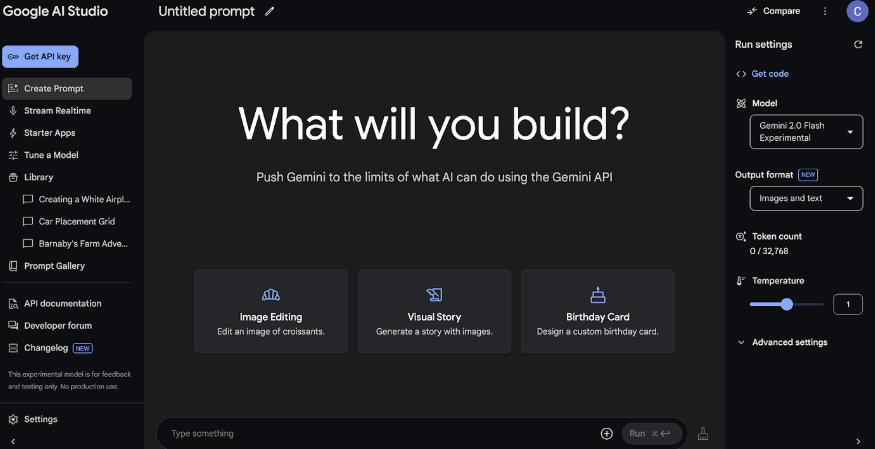Struggling to keep up with content demands? Discover how Google AI Studio can revolutionize your article creation process without costing a dime.
What You'll Learn:
- What Google AI Studio is and its benefits for article generation.
- Essential features and how to get started quickly.
- Techniques for crafting effective prompts to generate high-quality articles.
- How to fine-tune AI parameters for optimal content output.
- Integrating AI into your 2025 content strategy and future trends.
Understanding Google AI Studio: Your Free AI Content Assistant
In the dynamic world of content creation, staying ahead often means leveraging cutting-edge tools. Google AI Studio emerges as a powerful, free platform that democratizes access to advanced AI capabilities, particularly for generating articles. It empowers individuals and businesses alike to produce compelling written content efficiently.
What is Google AI Studio and Why It's Great for Article Generation
Google AI Studio is a web-based development environment that allows users to experiment with and prototype generative AI models, including those powering Google's Gemini family. For article generation, its significance lies in its accessibility and versatility. You don't need extensive coding knowledge to start creating. It offers a user-friendly interface to interact with sophisticated AI models, making it an ideal tool for bloggers, marketers, students, and anyone needing to produce written content. Its core advantage is providing a free gateway to powerful AI, enabling rapid content ideation, drafting, and refinement.
Key Features of Google AI Studio for Content Creators
Google AI Studio boasts several features that make it a standout choice for article generation:
- Intuitive Prompt Interface: A clean and straightforward chat-like interface for inputting prompts and receiving AI-generated text.
- Model Experimentation: Access to various Google AI models, allowing you to test which performs best for your specific article needs.
- Parameter Control: The ability to adjust key parameters like temperature and top-k to influence the creativity and randomness of the output.
- Pre-built Templates & Examples: Helpful starting points and demonstrations for various content types, including blog posts.
- API Integration (Optional): For those with development needs, it offers pathways to integrate these models into applications via APIs.
- Free Access: The most compelling feature is its cost-free nature, removing a significant barrier to entry for AI-powered content creation.
Getting Started: Signing Up and Navigating the Interface
Embarking on your AI article generation journey with Google AI Studio is straightforward:
- Sign Up: Visit the official Google AI Studio website. You'll need a Google account to sign in.
- Explore the Dashboard: Upon logging in, you'll see a dashboard. Look for options to start a new prompt or explore existing examples.
- Create a New Prompt: Click on “Create new prompt” or a similar button. This will open the main interaction window.
- Select a Model: Choose from the available models. For general article writing, models like Gemini Pro are excellent starting points.
- Begin Prompting: In the text input area, type your instructions for the AI.
The interface is designed for ease of use, resembling a chat application where you provide instructions and the AI responds.
Mastering Article Generation with Google AI Studio Prompts
The quality of AI-generated content is directly proportional to the quality of the prompts you provide. Think of prompt engineering as the art and science of communicating your intent to the AI.
The Art of Prompt Engineering for Articles
Effective prompt engineering involves being clear, specific, and contextual. Instead of a vague request like “Write an article about marketing,” aim for something more detailed.
Consider the difference:
- Poor Prompt: “Write about AI.”
- Good Prompt: “Write a 500-word blog post for small business owners explaining the benefits of using AI for customer service, focusing on chatbots and personalized recommendations. Include a call to action to explore AI solutions.”
This detailed prompt provides:
- Word Count: Sets expectations for length.
- Target Audience: Helps the AI tailor its language.
- Specific Topics: Guides the AI on what to cover.
- Desired Tone/Focus: Ensures the content aligns with your goals.
- Call to Action: Directs the AI to include a specific element.
Crafting Effective Prompts for Different Article Types
The structure of your prompt should adapt to the type of article you need:
- Blog Posts: Specify the topic, target audience, desired tone (e.g., informative, conversational, persuasive), key points to cover, and any specific keywords to include.
- News Articles: Provide key facts, the “who, what, when, where, why, and how,” and a desired angle or focus.
- How-To Guides: Clearly outline the steps involved, the problem being solved, and the desired outcome for the reader.
- Listicles: Request a specific number of items, the theme of the list, and any criteria for inclusion.
Example Prompt for a Listicles: “Generate a listicle titled '10 Essential Tools for Remote Workers in 2025′. For each item, provide a brief description of its function and why it's beneficial. The tone should be practical and helpful.”
Advanced Prompting Techniques: Few-Shot and Chain-of-Thought
For more complex or nuanced articles, consider these advanced techniques:
-
Few-Shot Prompting: Provide the AI with a few examples of the desired output format and content style before asking it to generate new content. This helps the AI understand your expectations more precisely.
Example: “Here are examples of engaging article introductions:
- [Example 1]
- [Example 2] Now, write an engaging introduction for an article about sustainable fashion.”
-
Chain-of-Thought (CoT) Prompting: Encourage the AI to “think step-by-step” or “explain its reasoning” before providing the final answer. This is particularly useful for articles requiring logical flow or problem-solving. While Google AI Studio's direct CoT implementation might differ from API calls, you can simulate it by asking the AI to outline its plan first.
Example: “Before writing the article on the impact of AI on the job market, first outline the key arguments you will present and the supporting evidence for each. Then, write the article.”
Leveraging Google AI Studio's Parameters for Content Quality
Google AI Studio allows you to fine-tune how the AI generates text by adjusting various parameters. Understanding these settings is crucial for achieving the desired content quality and style.
Understanding Key Parameters: Temperature, Top-P, and More
- Temperature: This parameter controls the randomness or creativity of the output.
- A low temperature (e.g., 0.1-0.4) results in more predictable, focused, and factual text. Ideal for technical articles or summaries.
- A high temperature (e.g., 0.7-1.0) leads to more diverse, creative, and sometimes surprising output. Great for brainstorming or creative writing.
- Top-P (Nucleus Sampling): This parameter also influences randomness but in a different way. It selects from the most probable next words whose cumulative probability exceeds a threshold P.
- A high Top-P (e.g., 0.9) allows for more variety.
- A low Top-P (e.g., 0.5) makes the output more focused and less random.
- Max Output Tokens: Sets a limit on the length of the AI's response. Useful for ensuring generated content fits within specific constraints.
- Stop Sequences: These are specific strings that, when generated by the AI, will cause it to stop generating further text. Useful for controlling the end of a paragraph or section.
Experimenting with Model Settings for Optimal Results
The best way to understand parameter impact is through hands-on testing.
- Start with a Base Prompt: Use a well-crafted prompt for your desired article.
- Generate with Default Settings: See what the AI produces initially.
- Adjust Temperature: Increase or decrease it and observe how the output changes. Does it become more interesting or too nonsensical?
- Adjust Top-P: Experiment with different values to see how it refines the word choices.
- Iterate: Combine different settings and re-generate until you achieve the desired tone, accuracy, and style for your article.
Integrating AI into Your 2025 Content Workflow
Google AI Studio is not just a standalone tool; it's a powerful addition to your existing content creation toolkit. Understanding how it fits into your workflow and comparing it with other options is vital for maximizing efficiency in 2025.
Google AI Studio vs. Gemini API: Choosing the Right Tool
While both leverage Google's AI models, they serve different purposes:
| Feature | Google AI Studio | Gemini API |
| Primary Use | Prototyping, experimentation, quick generation | Integration into applications, custom workflows |
| Technical Skill | Minimal to none required | Requires programming knowledge (Python, JS, etc.) |
| Cost | Free access to models | Usage-based pricing after free tier |
| Interface | Web-based, user-friendly chat interface | Code-based, direct interaction with models |
| Scalability | Good for individual tasks, less for mass production | Highly scalable for automated processes |
| Customization | Limited to prompt and parameter tuning | Extensive customization of model behavior |
For article generation, Google AI Studio is your go-to for direct, interactive creation and exploration. The Gemini API is better suited for developers building AI-powered content platforms or automating bulk content generation.
Practical Use Cases: Brainstorming, Drafting, and Editing
Google AI Studio can assist at multiple stages of the article writing process:
-
Brainstorming:
- Generate article ideas based on a broad topic.
- Develop catchy headlines and subheadings.
- Create outlines for your articles.
- Research supporting points for your arguments.
-
Drafting:
- Write entire sections or draft the first version of your article based on your outline.
- Expand on bullet points or brief notes.
- Generate different versions of paragraphs to choose from.
-
Editing & Refinement:
- Paraphrase existing content to avoid plagiarism or improve clarity.
- Summarize lengthy texts to extract key information.
- Check grammar and style (though dedicated tools may be more robust).
- Rephrase sentences for better flow or impact.
Best Practices for AI-Assisted Article Writing in 2025
To truly benefit from AI in 2025, adopt these best practices:
- AI as a Co-Pilot, Not Autopilot: Always review, edit, and fact-check AI-generated content. The AI is a tool to augment your creativity and efficiency, not replace your critical thinking.
- Maintain Your Voice: Edit the AI's output to ensure it aligns with your brand's unique voice and tone.
- Fact-Check Rigorously: AI models can sometimes generate inaccurate information or “hallucinate.” Verify all facts, statistics, and claims.
- Understand Your Audience: Tailor your prompts and edits to resonate with your specific readership.
- Ethical Disclosure: Consider disclosing when AI has been used in content creation, especially for sensitive topics or when transparency is paramount.
Maximizing Your Content Output: Tips and Future Trends
Leveraging AI for article generation is an evolving field. By understanding common pitfalls and future directions, you can stay ahead of the curve.
Common Pitfalls to Avoid in AI Content Generation
- Over-reliance: Blindly publishing AI-generated text without review.
- Generic Prompts: Using vague prompts that lead to bland, uninspired content.
- Ignoring Fact-Checking: Publishing AI-generated inaccuracies, which damages credibility.
- Lack of Editing: Failing to refine the AI's output to match your voice or improve clarity.
- Keyword Stuffing: Allowing the AI to unnaturally insert keywords, harming readability.
“The real power of AI in content creation lies in its ability to enhance human creativity and productivity, not replace it. Human oversight and editorial judgment remain indispensable.”
Ethical Considerations for AI-Generated Content
As AI becomes more prevalent, ethical considerations are paramount:
- Plagiarism: Ensure AI-generated content is original or properly attributed if it draws heavily from existing sources.
- Misinformation: Guard against the spread of false or misleading information generated by AI.
- Transparency: Be upfront with your audience about the use of AI in content creation where appropriate.
- Bias: AI models can inherit biases from their training data. Be mindful of and correct any biased output.
The Future of AI in Article Creation for 2025
The landscape of AI-assisted writing is rapidly advancing:
- More Sophisticated Models: Expect AI models to become even better at understanding nuance, context, and complex instructions.
- Personalized Content Generation: AI will likely be able to generate content tailored not just to an audience, but to individual reader preferences.
- Multimodal AI: AI systems will increasingly integrate text, images, audio, and video, allowing for richer content creation workflows.
- Enhanced Collaboration: AI tools will become more seamless collaborators, offering real-time suggestions and co-writing capabilities.
- Specialized AI for Niches: We'll see more AI models trained for specific industries or content types, offering even greater accuracy and relevance.
FAQ (Frequently Asked Questions)
Q: Is Google AI Studio truly free for article generation?
A: Yes, Google AI Studio provides free access to powerful generative AI models for experimentation and content creation. While there might be usage limits or potential future shifts, currently, it's a free resource for generating articles.
Q: Can Google AI Studio write an entire article for me?
A: Google AI Studio can generate drafts of entire articles based on your prompts. However, it's crucial to review, edit, and fact-check the output to ensure accuracy, coherence, and alignment with your intended message and voice. Think of it as a powerful assistant, not a fully autonomous writer.
Q: How do I ensure the AI-generated content is original and not plagiarized?
A: While AI models generate novel text, they are trained on vast datasets. To ensure originality, always review the output, use plagiarism checkers, and crucially, infuse your own unique perspective and edits. AI is a tool to help you create, not to copy.
Q: What is the best way to get started with prompt engineering for articles?
A: Start by being as specific as possible in your prompts. Include the topic, target audience, desired tone, key points, word count, and any specific keywords. Experiment with different phrasing and levels of detail to see what yields the best results.
Q: What happens if the AI generates incorrect information?
A: This is a common challenge with AI. Always fact-check any data, statistics, or claims made by the AI. Treat the generated content as a first draft that requires human verification and correction.
Conclusion
Google AI Studio stands as a remarkable, free resource for anyone looking to enhance their article generation capabilities. By mastering prompt engineering, understanding parameter tuning, and integrating it thoughtfully into your workflow, you can significantly boost your content output and quality in 2025. Remember to always maintain human oversight for accuracy, originality, and your unique brand voice.
Ready to revolutionize your content creation? Dive into Google AI Studio today and start experimenting!








